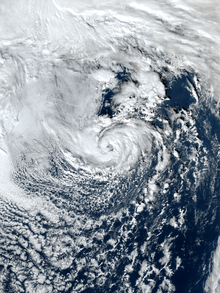Portal:Tropical cyclones
The Tropical Cyclones Portal

A tropical cyclone is a storm system characterized by a large low-pressure center, a closed low-level circulation and a spiral arrangement of numerous thunderstorms that produce strong winds and heavy rainfall. Tropical cyclones feed on the heat released when moist air rises, resulting in condensation of water vapor contained in the moist air. They are fueled by a different heat mechanism than other cyclonic windstorms such as Nor'easters, European windstorms and polar lows, leading to their classification as "warm core" storm systems. Most tropical cyclones originate in the doldrums, approximately ten degrees from the Equator.
The term "tropical" refers to both the geographic origin of these systems, which form almost exclusively in tropical regions of the globe, as well as to their formation in maritime tropical air masses. The term "cyclone" refers to such storms' cyclonic nature, with anticlockwise rotation in the Northern Hemisphere and clockwise rotation in the Southern Hemisphere. Depending on its location and intensity, a tropical cyclone may be referred to by names such as "hurricane", "typhoon", "tropical storm", "cyclonic storm", "tropical depression" or simply "cyclone".
Types of cyclone: 1. A "Typhoon" is a tropical cyclone located in the North-west Pacific Ocean which has the most cyclonic activity and storms occur year-round. 2. A "Hurricane" is also a tropical cyclone located at the North Atlantic Ocean or North-east Pacific Ocean which have an average storm activity and storms typically form between May 15 and November 30. 3. A "Cyclone" is a tropical cyclone that occurs in the South Pacific and Indian Oceans.
Selected named cyclone -
Hurricane Georges (/ʒɔːrʒ/) was a powerful and long-lived Cape Verde Category 4 hurricane which caused severe destruction as it traversed the Caribbean and Gulf of Mexico in September 1998, making seven landfalls along its path. Georges was the seventh tropical storm, fourth hurricane, and second major hurricane of the 1998 Atlantic hurricane season. It became the most destructive storm of the season, the costliest Atlantic hurricane since Hurricane Andrew in 1992 and remained the costliest until Hurricane Charley in 2004, and the deadliest since Hurricane Gordon in 1994. Georges killed 604 people, mainly on the island of Hispaniola, caused extensive damage resulting at just under $10 billion (US dollars in 1998) in damages and leaving nearly 500,000 people homeless in St. Kitts and Nevis, Puerto Rico, Hispaniola and Cuba.
The hurricane made landfall in at least six countries (Antigua and Barbuda, St. Kitts and Nevis, Haiti, the Dominican Republic, Cuba, and the United States), more than any other hurricane since Hurricane Inez of the 1966 season. Throughout its path of destruction, it caused extreme flooding and mudslides, as well as heavy crop damage. Thousands were left homeless as a result of the storm in the Lesser Antilles, and damage in those islands totaled abour US$880 million. In the Greater Antilles, hundreds of deaths were confirmed, along with over $2.4 billion in damages. Hundreds of thousands were left homeless, due to catastrophic flooding, torrential rainfall, and high storm surge. Flooding was exacerbated heavily by coastal defenses being broken from high waves. Crops were heavily damaged, and thousands of houses were destroyed due to mudslides. (Full article...)Selected article -

The 1975 Pacific hurricane season officially started May 15, 1975, in the eastern Pacific, and June 1, 1975, in the central Pacific, and lasted until November 30, 1975. These dates conventionally delimit the period of each year when most tropical cyclones form in the northeast Pacific Ocean.
The 1975 Pacific hurricane season was slightly above average, with 17 tropical storms forming. Of these, 9 became hurricanes, and 4 became major hurricanes by reaching Category 3 or higher on the Saffir-Simpson Hurricane Scale. The only notable storms are Hurricane Olivia, which killed 30 people, caused $30 million (1975 USD) in damage, and left thousands homeless when it made landfall in October; and an unnamed hurricane that developed at very high latitude, but had no effect on land. Hurricane Denise was the strongest storm of the year. Hurricanes Lily and Katrina passed close to Socorro Island and Tropical Storm Eleanor made landfall in Mexico. Hurricane Agatha sank a ship.
(Full article...)Selected image -
Selected season -

The 1995 Pacific hurricane season was the least active Pacific hurricane season since 1979,[1] and marked the beginning of a multi-decade period of low activity in the basin. Of the eleven tropical cyclones that formed during the season, four affected land, with the most notable storm of the season being Hurricane Ismael, which killed at least 116 people in Mexico. The strongest hurricane in the season was Hurricane Juliette, which reached peak winds of 150 mph (240 km/h), but did not significantly affect land. Hurricane Adolph was an early-season Category 4 hurricane. Hurricane Henriette brushed the Baja California Peninsula in early September.
The season officially started on May 15, 1995, in the Eastern Pacific, and on June 1, 1995, in the Central Pacific, and lasted until November 30, 1995. These dates conventionally delimit the period of each year when most tropical cyclones form in the northeastern Pacific Ocean. The season saw eleven tropical cyclones form, of which ten became tropical storms. Seven of these storms attained hurricane status, three of them becoming major hurricanes. There were fewer tropical storms than the average of 16, while the number of hurricanes and major hurricanes were slightly below average. (Full article...)Related portals
Currently active tropical cyclones

Italicized basins are unofficial.
- North Atlantic (2024)
- No active systems
- East and Central Pacific (2024)
- No active systems
- Mediterranean (2023–24)
- No active systems
- South-West Indian Ocean (2023–24)
- No active systems
- Australian region (2023–24)
- No active systems
- South Pacific (2023–24)
- No active systems
- South Atlantic (2023–24)
- No active systems
Last updated: 18:32, 26 May 2024 (UTC)
Tropical cyclone anniversaries

June 1,
- 2007 - Tropical Storm Barbara (pictured) starts weakening as it was reported that it had damages a total of US$55 million and killed 4 people.
- 2024 - The Central Pacific and Atlantic hurricane seasons officially begin.

June 2,
- 2003 - Severe Tropical Storm Nangka reached its peak intensity to the south of Taiwan.
- 2007 - As a rapidly weakening storm, Tropical Depression Barry (pictured) makes landfall over in Florida before transitioning into an extratropical cyclone. Barry only killed three people in its path with damages of only $118 thousand.
June 3,
- 1982 - Tropical Storm 02B made landfall in India near Paradip, killing 140 people and destroying half a million homes.
- 2010 - Cyclone Phet struck eastern Oman, dropping heavy rainfall across normally arid areas; the storm killed 47 people and left US$861 million in damage.
- 2014 - Tropical Storm Boris makes landfall over in Southwestern Mexico as a weak system, killing a total of six people and US$46.8 million worth of damages.
Did you know…




- …that the Joint Typhoon Warning Center considers that Typhoon Vera (pictured) of 1986 is actually two distinct systems, formed from two separated low-level circulations?
- …that Hurricane Agatha (pictured) was the strongest Pacific hurricane to make landfall in Mexico in May since records began in 1949?
- …that Cyclone Raquel (track pictured) travelled between the Australian and South Pacific basins between the 2014–15 and 2015–16 seasons, spanning both seasons in both basins?
- …that Cyclone Amphan (pictured) in 2020 was the first storm to be classified as a Super Cyclonic Storm in the Bay of Bengal since 1999?
General images -

An off-season Atlantic hurricane is a tropical or subtropical cyclone that existed in the Atlantic basin outside of the official Atlantic hurricane season. The National Oceanic and Atmospheric Administration currently defines the season as occurring between June 1 and November 30 each calendar year, which is when 97% of all Atlantic tropical cyclones occur. Peak activity is known to be between August and October. Between 1938, when the United States Weather Bureau began issuing tropical cyclone warnings as a collaborative observation network for cities along the U.S. coastline, and 1963, the season was defined between June 15 and November 15. In 1964, the season was extended to begin on June 1 and end on November 30, which remains the official length of the season.
, there have been 92 off-season cyclones recorded in the official Atlantic hurricane database, which dates back to 1851. In addition, six earlier such storms have been documented, but are not part of the database. The first off-season storm in the database was an 1865 storm that developed in the Caribbean Sea; an earlier documented 1863 hurricane is not part of the database. The most recent off-season system was an unnamed January subtropical storm in 2023. (Full article...)Topics
Subcategories
Related WikiProjects
WikiProject Tropical cyclones is the central point of coordination for Wikipedia's coverage of tropical cyclones. Feel free to help!
WikiProject Weather is the main center point of coordination for Wikipedia's coverage of meteorology in general, and the parent project of WikiProject Tropical cyclones. Three other branches of WikiProject Weather in particular share significant overlaps with WikiProject Tropical cyclones:
- The Non-tropical storms task force coordinates most of Wikipedia's coverage on extratropical cyclones, which tropical cyclones often transition into near the end of their lifespan.
- The Floods task force takes on the scope of flooding events all over the world, with rainfall from tropical cyclones a significant factor in many of them.
- WikiProject Severe weather documents the effects of extreme weather such as tornadoes, which landfalling tropical cyclones can produce.
Things you can do
 |
Here are some tasks awaiting attention:
|
Wikimedia
The following Wikimedia Foundation sister projects provide more on this subject:
-
Commons
Free media repository -
Wikibooks
Free textbooks and manuals -
Wikidata
Free knowledge base -
Wikinews
Free-content news -
Wikiquote
Collection of quotations -
Wikisource
Free-content library -
Wikiversity
Free learning tools -
Wikivoyage
Free travel guide -
Wiktionary
Dictionary and thesaurus
- ^ National Hurricane Center; Hurricane Research Division; Central Pacific Hurricane Center (April 26, 2024). "The Northeast and North Central Pacific hurricane database 1949–2023". United States National Oceanic and Atmospheric Administration's National Weather Service. Archived from the original on May 29, 2024. A guide on how to read the database is available here.
 This article incorporates text from this source, which is in the public domain.
This article incorporates text from this source, which is in the public domain.
























































